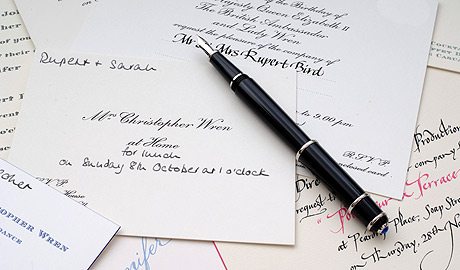The etiquette of weddings has changed over the years, but the invitations still come with some hard and fast rules. Why? Probably because they offer pertinent information that guests must attend to. It is too easy to focus on the niceties of the invitation like the quote or the design qualities, and forget to put in an essential detail.
The goal is to convey to family and friends the joy of the occasion while still providing them with specifics like the date and R.S.V.P. options. As you and your partner begin this journey that will lead you down the aisle, consider some tips on getting the invitation just right.
Picking a Tone
It starts with deciding what type of wedding you want. This one decision serves as the core for many other choices you make about the special day.
- Formal
- Causal
- Small
- Low-key
These are all descriptive phrases that define the tone of the wedding, and subsequently, the invitation. Your invitation choice should provide the guest with an idea of the wedding format. An invitation printed on linen stock and served up in satin envelopes says traditional and formal. A single sheet with “We are finally getting married” in big bold letters provides an air of informality and fun.
Design Absolutes
Once you work out the tone, the next thing to decide is the invitation layout. There are some absolute necessities to consider.
Keep the language clear at all times. Unless you are quoting Shakespeare, you want the guest to know exactly what each line means in the invitation.
Location: The corner church at 13 th and N
That may seem like an obvious address to you, but are you sure there is only one church at that intersection? Is that N street, avenue or boulevard? Make each line count for something.
Avoid a design that is too busy: Simple equals elegant. If you opt for an abundance of graphics, stay on point. If you are having a destination or themed wedding, for instance, let the extra art tell that story.
Use an easy-to-read font: Script and fancy type look nice, but are sometimes hard to decipher. It is possible to pick a typeface that is both clear and rich looking. When selecting an ink color, pick something that matches the design, is one of the wedding colors or goes with black. If opting for a wedding color, consider making the envelope lining the other color to create a set. If your colors are pink and silver, the ink could be a dark pink and the envelope lining matching silver or vice versa.
Spell out dates on formal invitations: Saturday, the seventh of January, two-thousand and fourteen at four o’clock in the afternoon. If the tone is causal, Saturday, January 7, 2014 at 4:00 p.m. is fine.
Wedding Invitation Q&A
When do the wedding invitations go out?
Ideally, the invitations are in the mail six to eight weeks before the ceremony. For destination weddings, it is standard to send a “save the date” notice six to eight months ahead of time to allow traveling guests time to plan ahead.
Does the invitation contain gift information?
This is a major etiquette faux pas. It is better to let your wedding party and family spread the word about the gift registry. If putting up a wedding website, provide that information there, as well.
Is it necessary to offer a “plus-one” option?
No, it is appropriate to invite single guests without offering to host a plus-one. A few may misunderstand this subtle hint, though. In that case, they will most likely note a guest or date on their R.S.V.P. You have the option to accept that additional person or give them a call and explain.
Can you invite people to the ceremony only?
Are there rules for addressing the envelopes?No, the opposite is proper, however. If you prefer an intimate wedding and a more open reception, it is okay to send “reception only” invites.
Yes, first, the return address goes on the back flap of the outer envelope. The return is from the hosting party, so if the invite designates the bride’s parents as hosts, their address goes on the envelope. Never use stick on labels for the return address.
The front is for the addressee. Use formal language with Mr., Mrs., Ms., or titles such as Dr. or Capt. List children on the envelope, as well, if they are invited. Repeat the title and last name of each guest on the face of the inner envelope.
How to Handle Those Tricky Situations
Not every wedding scenario is perfect, but most have a solution. Consider some common problems that might cause confusion when putting together the wedding invitation.
Divorced Parents: If the parents are divorced but still hosting the wedding together, list the names on separate lines with the mother first. Exclude any connector between the two names such as “and.”
Remarried Parents: The rules are similar for children who want to include stepparents on the invitation. Use separate lines with the mother and her husband listed first.
Deceased Parents: Do not list the names of deceased parents on invitations. If both parents are gone, it is fine to substitute another relative such as grandparents or even the name of the couple.
Miss Anne Smith
and
Mr. James Q. Public
request the honor of your presence at their marriage
Tackling invitations is just one of many tasks that come with planning a wedding, but a crucial one to get right. Following some basic etiquette will smooth out the process and give guests everything they need to help you celebrate.


